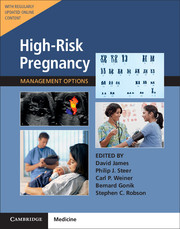Book contents
- Frontmatter
- Contents
- List of Contributors
- Preface
- Section 1 Prepregnancy Problems
- Section 2 Early Prenatal Problems
- 5 Bleeding and Pain in Early Pregnancy
- 6 Recurrent Miscarriage
- 7 Screening for Fetal Abnormality in the First and Second Trimesters
- 8 Invasive Procedures for Prenatal Diagnosis
- Section 3 Late Prenatal – Fetal Problems
- Section 4 Problems Associated with Infection
- Section 5 Late Pregnancy – Maternal Problems
- Section 6 Late Prenatal – Obstetric Problems
- Section 7 Postnatal Problems
- Section 8 Normal Values
- Index
7 - Screening for Fetal Abnormality in the First and Second Trimesters
from Section 2 - Early Prenatal Problems
- Frontmatter
- Contents
- List of Contributors
- Preface
- Section 1 Prepregnancy Problems
- Section 2 Early Prenatal Problems
- 5 Bleeding and Pain in Early Pregnancy
- 6 Recurrent Miscarriage
- 7 Screening for Fetal Abnormality in the First and Second Trimesters
- 8 Invasive Procedures for Prenatal Diagnosis
- Section 3 Late Prenatal – Fetal Problems
- Section 4 Problems Associated with Infection
- Section 5 Late Pregnancy – Maternal Problems
- Section 6 Late Prenatal – Obstetric Problems
- Section 7 Postnatal Problems
- Section 8 Normal Values
- Index
Summary
Introduction
Congenital anomalies are found in 3–8% of all fetuses and newborns. They include embryological defects but also destructive sequences that usually start with a vascular, infectious, or chemical insult that later results in various defects in different parts of the body, though the brain and spinal cord are particularly sensitive. Prenatal fetal abnormality screening programs developed to detect these anomalies normally comprise a combination of ultrasound examinations and biochemical investigations. Their use results in a suspected or actual diagnosis in 40–90% of screened women. This figure is dependent on:
• the type of abnormality
• the gestational age when the screening is performed
• the content of the prenatal screening program offered to pregnant women
It is important that advice, guidelines, and recommendations should be in place, complemented by sound and appropriate referral patterns and clinical management protocols. The coherence and effectiveness of a screening policy can be judged by:
• the quality of counseling
• the quality of the guidelines/protocols it uses
• the extent of the cover of the pregnant population
• the quality of staff teaching
• the quality of auditing
Weblinks
Public Health England. Fetal anomaly screening: programme handbook. https://www.gov.uk/
government/publications/fetal-anomaly-screeningprogramme- handbook (accessed March 2017)
NICE. Screening for fetal anomalies. In Antenatal care for uncomplicated pregnancies. http:// www.nice.org.uk/guidance/CG62/chapter/ 1-Guidance#screening-for-fetal-anomalies (accessed March 2017)
SOGC. Counselling considerations for prenatal genetic screening. http://www.jogc.com/article/ S1701-2163(16)35248-3/pdf (accessed March 2017)
Ultrasound
Ultrasound (US) is central to screening for fetal abnormality in the first and second trimesters of pregnancy. However, it is a modality that is highly dependent both on the level of technology, quality, and performance of the equipment used, and also on the skill and knowledge of the operator. At least half of the severe malformations diagnosed later in pregnancy could be picked up at 11+0 to 13+6 weeks. Not surprisingly, the highest detection rate in the first trimester is found when there is an increased likelihood of recurrence following an index case or a high risk specifically identified prior to the ultrasound examination.
- Type
- Chapter
- Information
- High-Risk Pregnancy: Management OptionsFive-Year Institutional Subscription with Online Updates, pp. 149 - 189Publisher: Cambridge University PressFirst published in: 2017
- 1
- Cited by



